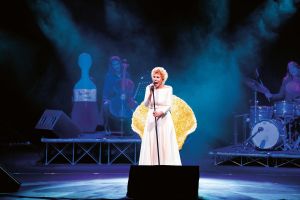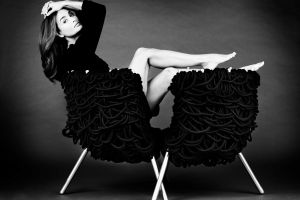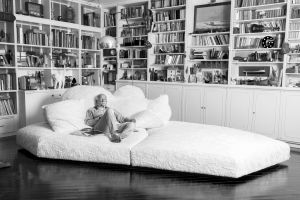
October 2023
Silvana Annicchiarico
Tale of a lifetime, in one evening.
Thank you!
A single word was enough for Francesco Binfaré to convey all the emotion he felt to the audience gathered in the stalls and on the boxes of La Scala theatre: "For days, I have been mentally preparing the speech I wanted to make this evening," he said. "Over and over, I repeated it to myself. But now that I stand here before you, in this magnificent theatre, I have but one word to say...". A pause. A moment of suspense. And then, precisely, "Thank you!". Emotion pours tumultuously from the stage into the hall and long, warm, participating, heartfelt applause shows how much that feeling is shared.
It is 9 June. The Salone del Mobile 2022 is in full swing, and one of the most eagerly awaited events is taking place in the theatre that symbolises the city and Italian excellence around the world: Valerio and Monica Mazzei wanted La Scala for the premiere of the film portrait that Giovanni Gastel dedicated to Francesco Binfaré and his relationship with Edra. There, in that superb setting, in a theatre saturated with history and memory, the work of two visionaries such as Giovanni Gastel (who had created Edra's advertising images since 2015) and Francesco Binfaré (who has been designing artefacts of cosy elegance and astonishing beauty for Edra since 1992) could not fail to enchant.
That evening, you could feel the magic everywhere: in the air, in the lights, and in the silence. And, of course, in the film: seated on the Pack sofa, with the polar bear-shaped backrest, sculpted in a black and white of dazzling clarity, Binfaré looks into the camera lens and talks about himself, his work, and his dreams. And Gastel scrutinises him. With respect, admiration, and discretion. Everything passes through the eyes. Because Gastel had this extraordinary ability of revealing himself by revealing the other.
This intense film portrait (one of the last works by the Milan-born Maestro, who died prematurely in March 2021) condenses all the grace and elegance with which Gastel knew how to shape things. His gaze on Binfaré is never brash or invasive. He stands at the "right distance" waiting for him. He welcomes him into the picture. And then he thrusts him out as if he were a bas-relief in motion. What emerges is the portrait of an innovative designer who challenged canons and commonplaces, radically changing the very way of conceiving the sofa-shape inside the home.
Before him, sofas were almost micro-architectures. They had a rigid structure and a fixed shape: the backrest here, the seat there. Binfaré, instead, deconstructed the sofas. He freed them from the typological, technological and constructive constraints they had been carrying around for centuries. On the set, during a break in the shooting of the film made by Gastel based on an interview with me, he confessed to me "For me, sofas are travelling mini-installations. They generate behaviours and performances in space. I observe people, and through their gestures, they tell me how they would like to sit. That’s where I start from".
In his Piccola storia del divano (A short history of the sofa), Alessandro Mendini has clearly shown that, in recent decades the sofa has been the furnishing element that has most "felt" the technological mutations and social transformations. In 20th-century bourgeois Italy, it determined the conversation etiquette in the living room. Then, TV arrived, and the sofa increasingly took on a form that would allow a comfortable observation of the centrally placed TV totem. Later, with the advent of social media, little by little, the TV lost its gravitational centrality even in the living space. Still, the sofa continued to shape its surroundings and to be the utmost sacred point in the home, the centre of that primary and ineradicable function: the ritual of being together.
Attentive to social function and individual needs, Binfaré stands at the crossroads of complex cultural stratifications. Christine Colin, who dedicated an in-depth and illuminating study to him - published by Electa - proposes reading his work in the light of the lessons of Marcel Duchamp and Mircea Eliade. A suggestive proposal, as long as we don’t forget that, in designing his sofas, Binfaré has always been first and foremost a visionary. That was true when he directed the Cassina Research Centre in the 1970s, and even more so now, when he succeeds in involving a courageous company like Edra in his unprejudiced adventures and creative experiments.
"I think that a very strong erotic tension is released in creating something that is not there," he told me in a passionate tone. "You have to give life to something that does not exist; you have to infuse it with soul."
This tension is felt in all his "creations". Just as one can feel the erotism of the project. Heir to the lesson of Vico Magistretti, with whom he collaborated when he worked for Cassina, but also a supporter of a heterodox vision such as that of Gaetano Pesce, Binfaré is convinced that designing means first and foremost knowing how to communicate an idea. Knowing how to light a fire in the mind of the entrepreneur who then has to realise it. "When you meet the client," he says, "you don't have to have a project, but an idea. You have to know how to communicate it. You have to involve the other person. And in this process, the energy exchange is essential". This is how his sofas were born: from the ability to make a company fall in love with his vision.
Accustomed to waking up as early as 5 a.m., at that moment suspended between sleep and wakefulness, Binfaré confesses that he often has visions: "Once I dreamt of a red desert on which it was raining black. Oil, perhaps. A small red island sprouted out of this black sea. I went to the kitchen to look for a pencil and mark the shape of this little island, but I found no pencils. So, I took a pair of scissors and cut the shape out of the paper. Then, I made some cross cuts and folds. That is how Flap was born: a raft with parts that rise up. Edra already had a joint that worked for horizontal movements; it was just a matter of creating another one for vertical movements."
Technology at the service of vision, not vice versa. And absolute freedom in imagining new, multifunctional forms with the collaboration of a company such as Edra that believes in the need to avoid the flattening effect of globalisation on both objects and thought. Each of Binfaré's projects arises from a particular inspiration. "At the beginning," he wrote in one of his texts in 2013, "there is an empty imaginary space in my mind, like a theatre scene waiting for the story. At a certain point, a narrative begins to emerge, and gradually the sofa takes shape, fills the scene by itself, and becomes the shape of the story". This idea that designing has to do with storytelling and that the home can be compared to an empty stage where furniture can give expression to a possible narrative is recurrent in Binfaré as in other great innovators of his generation, from Gaetano Pesce to Alessandro Mendini. If it is not narrative, the matrix of inspiration comes from the careful observation of gestures, habits and needs.
Just one example: during one summer in Apulia, Binfaré observes bathers sunbathing on the rocks and cliffs. In theory, bodies should be uncomfortable in that position, but in fact, they adapt to the configuration of the place and find a suitable position. Binfaré discusses this with Valerio Mazzei, who has just developed the Gellyfoam, an innovative material capable of accommodating any position of the body. Thanks to this polyurethane jelly, the On the Rocks sofa was born. Here, Binfaré separates the backrest from the seat to obtain a totally free, unconstrained form, allowing full movement on the surface. On the other hand, a sofa like Pack was born from the observation of nature: a bear lying on pack ice, which can move freely. "I imagined that if the world could be defined as a surface that is breaking up and splitting into many small units, like the ice pack, the bear could represent the symbol of a great emotional dimension". Sfatto, on the other hand, has a cultural genesis. It was born from a vision of a painting by Lucian Freud, Big Sue, where a woman is lying in an unseemly manner on a Chesterfield sofa made of cretonne: "Sfatto", recalls Binfaré, "was born at a time when I perceived the fatigue of the western world, its gravity, its decadence. The painting conveyed these feelings to me. And I tried to transfer them to a sofa: a typical bourgeois sofa, but unmade and untidy".
Is the sofa the hub of contemporary living? Binfaré is convinced of this. So much so, that in the film portrait that Giovanni Gastel dedicated to him, he chooses to speak seated on one of his sofas, Pack, the one with the seat the colour of polar ice and the backrest in the shape of a polar bear. As he speaks, he strokes the bear's head. It is a spontaneous gesture, not planned, probably not even meant. But precisely for this reason - as Barthes would say - it is a gesture that 'stings': because it expresses and summarises all the potential tenderness of the creator towards his creature. Because it reveals the intimate and conspiratorial relationship that every designer has with the outcome of his work. And it is precisely this intimacy that Giovanni Gastel's film (which can now be seen in its integral version on edra.com) successfully highlights with delicacy and complicity: not the icy portrait of an artist scrutinised with detachment, nor a collection of apologetic declarations made by more or less interested admirers, but almost a confession, a poetic statement, the disclosure of a method.
As the images slide on the big screen set on the theatre stage where immortal music and arias usually resound, in the auditorium the audience starts feeling that there is something - even in that black and white - that defies time and fashion trends, and that comes close to one of the primary needs of every human being: the desire to have a place to take refuge, a den-house in which to protect oneself from the pitfalls of the world. For more than half a century Francesco Binfaré has worked and created to offer his answers to this desire/need. And he did it in a surprising and visionary way. Only another visionary as Gastel could grasp the meaning and value of his work with such clarity. On the evening of 9 June, Valerio and Monica Mazzei were also moved and touched on stage at La Scala. They were aware that they had personally contributed to giving shape and voice to the imagination of two creators. And in this way, they have contributed to generating the enchantment.
 |
Silvana Annicchiarico Architect, lives in Milan and works as a researcher, critic and teacher. She is consultant for public organisations and private companies. In the exhibitions and publications she is involved in, she deals with contemporary issues, the works of the great masters and the new names of design. From 2007 to 2018, she was Director of the Triennale Design Museum at Triennale Milano. |











